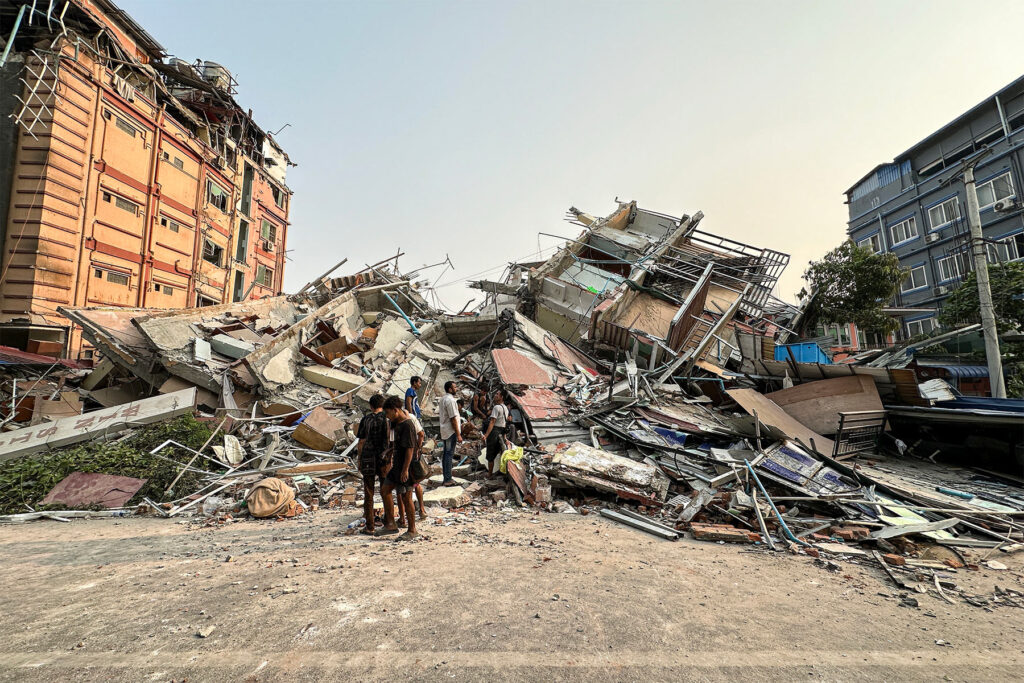President Donald Trump has vowed U.S. assistance in response to a devastating earthquake that rocked Myanmar and Thailand on Friday, killing at least 150 people and leaving many trapped under collapsed buildings.
Speaking to reporters in Washington, Trump confirmed that his administration had already taken steps to provide help. “We’re going to be helping. We’ve already alerted the people. Yeah, it’s terrible what happened,” he said.
However, his administration’s significant cuts to foreign assistance through the U.S. Agency for International Development (USAID) and the State Department could hinder the response efforts. The 7.7 magnitude earthquake has led to widespread destruction, with high-rise buildings in Bangkok collapsing and hospitals scrambling to care for the injured.
Foreign Aid System ‘in Shambles’
Sarah Charles, a former senior USAID official under the Biden administration, expressed concerns over the agency’s ability to respond quickly due to staff and resource reductions. “The system is now in shambles,” Charles said, highlighting that critical response teams may struggle to reach survivors in time.
USAID has traditionally played a key role in international disaster response, dispatching teams of experts, equipment, and essential supplies within hours. Yet, experts warn that mass layoffs and program terminations under Trump’s leadership have left major gaps in the agency’s operational capacity.
State Department’s Role in Disaster Relief
State Department spokesperson Tammy Bruce assured reporters that the administration was evaluating requests for assistance and reports from affected areas to determine the best course of action.
“USAID has maintained a team of disaster experts with the capacity to respond if disaster strikes,” Bruce said. “These expert teams provide immediate assistance, including food and safe drinking water, needed to save lives in the aftermath of a disaster.”
Despite these assurances, Bruce’s remarks come on the same day that Secretary of State Marco Rubio and Jeremy Lewin, a former Musk associate now in a senior USAID role, announced a new round of USAID layoffs and the transfer of its remaining programs to the State Department.
Cuts to Disaster Response Capabilities
Since Trump’s return to office on January 20, his administration has significantly reduced U.S. foreign aid, working alongside Musk’s teams to reshape international assistance policies. Thousands of contract terminations and staff dismissals have disrupted global development programs, leaving many allies and partners scrambling to fill the void.
Experts say these cuts could seriously undermine the effectiveness of the U.S. response to the Southeast Asia disaster. In previous crises, USAID-backed urban search-and-rescue teams from Los Angeles County and Fairfax County, Virginia, were deployed within 24 hours. However, budget reductions have reportedly eliminated essential transport contracts for these teams, potentially delaying their deployment.
Moreover, reductions in staffing have crippled coordination efforts with international allies, which are crucial in directing rescue operations and delivering humanitarian aid.
A Strained Global Aid Network
The fallout from the Trump administration’s foreign aid overhaul has extended beyond USAID. Cuts to emergency response programs in partnership with the United Nations and other global organizations have further weakened disaster relief capabilities worldwide.
As Southeast Asia grapples with the aftermath of Friday’s earthquake, the effectiveness of the U.S. response will be closely watched. While Trump has pledged assistance, the impact of his administration’s cuts to America’s long-standing disaster relief infrastructure may soon be put to the test.
Stay updated with Amnewsworld for further developments on this story.



